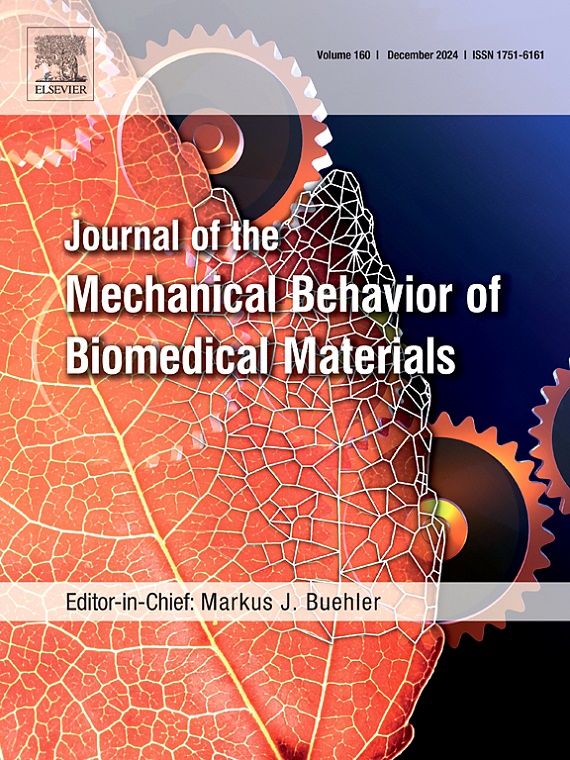Deep learning reduced order models of vaginal tear propagation
IF 3.5
2区 医学
Q2 ENGINEERING, BIOMEDICAL
Journal of the Mechanical Behavior of Biomedical Materials
Pub Date : 2025-06-05
DOI:10.1016/j.jmbbm.2025.107074
引用次数: 0
Abstract
Childbirth often has traumatic consequences that profoundly affect the mother’s health. The passage of a baby through the vagina causes tissue lacerations, such as vaginal tears, which lead to pelvic floor disorders later in life. Despite advances in obstetrics, accurately predicting the possible complications of vaginal delivery remains challenging with current clinical methods. This paper introduces new computational methods that integrate finite element (FE) analysis, proper orthogonal decomposition (POD), and machine learning (ML) to predict vaginal deformations and tearing. Based on ex vivo micro-mechanical data collected from rodents, FE models of the vaginal canal subjected to increasing pressure with propagating tears are created. Snapshots of the FE displacement fields at increasing pressures and with different collagen fiber organization in the proximal, mid, and distal regions of the vagina are then used to develop (a) full-order ML models and (b) POD-based reduced order models with coefficients computed using ML. Both the full-order ML models and POD-ML models with POD bases of dimension approximated the FE results with root squared mean errors of . Training (offline) times for the ML and POD-ML models were and seconds, respectively, whereas prediction (online) times for both ML and POD-ML models were seconds. Thus, the POD-ML models outperformed the ML models in terms of training efficiency while achieving similar prediction accuracy. Our findings demonstrate that the integration of these techniques can lead to faster computations of vaginal delivery outcomes. POD-based reduced order models and ML-based computational tools emerge as non-invasive methods for quantifying vaginal tissue deformations and tears.
阴道撕裂传播的深度学习降阶模型
分娩往往会带来严重影响母亲健康的创伤性后果。婴儿通过阴道会导致组织撕裂,如阴道撕裂,从而导致以后的盆底疾病。尽管产科技术取得了进步,但目前的临床方法仍难以准确预测阴道分娩可能出现的并发症。本文介绍了结合有限元(FE)分析、正交分解(POD)和机器学习(ML)的新的计算方法来预测阴道变形和撕裂。基于啮齿动物的离体微力学数据,建立了阴道在不断增加的压力和不断扩展的撕裂作用下的有限元模型。然后,利用阴道近端、中端和远端不同胶原纤维组织下压力增加时FE位移场的快照,建立(a)全阶ML模型和(b)基于POD的降阶模型,使用ML计算系数。全阶ML模型和POD基维为1≥2的POD-ML模型与FE结果近似,其平方根平均误差为0(10−2)。ML和POD-ML模型的训练(离线)时间分别为O(102)和O(10)秒,而ML和POD-ML模型的预测(在线)时间均为O(10−3)秒。因此,POD-ML模型在训练效率方面优于ML模型,同时达到相似的预测精度。我们的研究结果表明,这些技术的整合可以更快地计算阴道分娩结果。基于pod的降阶模型和基于ml的计算工具成为量化阴道组织变形和撕裂的非侵入性方法。
本文章由计算机程序翻译,如有差异,请以英文原文为准。
求助全文
约1分钟内获得全文
求助全文
来源期刊

Journal of the Mechanical Behavior of Biomedical Materials
工程技术-材料科学:生物材料
CiteScore
7.20
自引率
7.70%
发文量
505
审稿时长
46 days
期刊介绍:
The Journal of the Mechanical Behavior of Biomedical Materials is concerned with the mechanical deformation, damage and failure under applied forces, of biological material (at the tissue, cellular and molecular levels) and of biomaterials, i.e. those materials which are designed to mimic or replace biological materials.
The primary focus of the journal is the synthesis of materials science, biology, and medical and dental science. Reports of fundamental scientific investigations are welcome, as are articles concerned with the practical application of materials in medical devices. Both experimental and theoretical work is of interest; theoretical papers will normally include comparison of predictions with experimental data, though we recognize that this may not always be appropriate. The journal also publishes technical notes concerned with emerging experimental or theoretical techniques, letters to the editor and, by invitation, review articles and papers describing existing techniques for the benefit of an interdisciplinary readership.
 求助内容:
求助内容: 应助结果提醒方式:
应助结果提醒方式:


